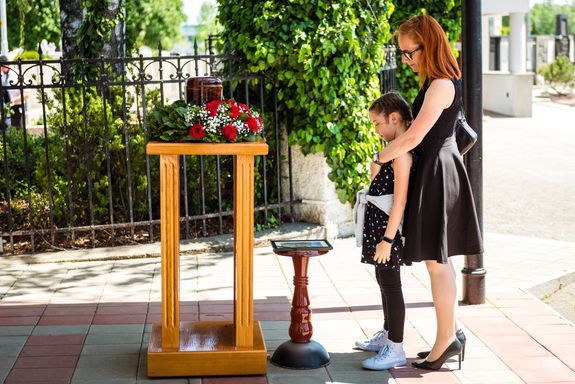What is Direct Cremation and How Does it Work?
Cremation is the top disposition option for Americans, and different types of cremation services are popping up to meet demand. One option is direct cremation, and it’s quickly becoming a popular choice for many families.
Direct cremation is different than traditional cremation in several ways. We’ll go into what those differences are, but the important point is this – if you’re concerned about cost or complexity, direct cremation could be an ideal disposition option for you or your loved one.
What Do Direct Cremation Services Include?
Direct cremation services usually include the following:
- Direct disposal services and staff – Direct disposal services include responding to calls, retrieving the decedent’s remains, arranging for cremation with the client, and providing clerical assistance for all necessary forms.
- Refrigeration – The decedent’s remains are not embalmed prior to cremation, therefore refrigeration is required. Direct cremation service fees include several days’ worth of refrigeration, but more can be added, if needed.
- Transportation – This includes transportation from the place of death to the mortuary, and from the mortuary to the crematory.
- Crematory fee – This is the fee required by the crematory to handle the remains, cremate them, and recover the ashes.
- Alternative container – Direct cremation services do not require a casket. Instead, an alternative container (a cardboard box) is provided to hold the remains during the cremation process.
The above services are the minimum necessary for direct cremation. The associated costs are around $1,000 in most cases, but some direct cremation companies can do it for around $800.
How does this compare to the cost of other disposition options?
- Memorial service with cremation – Between $2,500 and $5,000, depending on location.
- Traditional funeral service and burial – Between $6,000 and $9,000 in most cases, though it can run up to $12,000 or more in some areas.
Urns, Caskets and Additional Services Can Be Added to Direct Cremation
Cost is one of direct cremation’s benefits, but families may add onto their cremation package if they wish. Some of those goods and services include:
- A wooden, metal or ornamental urn
- A casket, instead of an alternative container
- Additional death certificates
- Expedited or rush cremation services
- Delivery of remains to a residence or cemetery
- Dividing the cremated remains into multiple containers
- Packaging and mailing the remains (within the continental U.S.)
While these goods and services will increase the price of direct cremation, they allow loved ones to be flexible with how they plan final arrangements.
Is Direct Cremation Regulated Like Other Funeral Services?
The Federal Trade Commission regulates the funeral industry through its Funeral Rule. Direct cremation services are also required to abide by this rule.
The Funeral Rule requires cremation services to provide transparent pricing and a simple purchasing process. Transparent pricing includes an itemized list of all fees, so the family can review everything prior to purchase. Further, cremation services must inform people of all options pertaining to goods and services. In short, consumers must be aware of all their choices when making cremation arrangements.
Also, direct cremators must maintain a direct disposer license to provide cremation services in their state. This license ensures the recovery team is trained in safely and properly handling human remains following death.
With these regulatory measures in place, families can opt for direct cremation without fear.
How is Direct Cremation Different Than Other Cremation Options?
We’ve already addressed the difference in cost, which can be thousands of dollars depending on what services are required and where cremation is taking place.
However, there are other differences with direct cremation, including:
- You don’t have to work with a funeral home – With traditional funeral or memorial services, you’ll need a funeral home. The funeral home provides everything needed for a traditional service, including the venue itself. However, funeral home services are expensive, are time-constrained, and may not offer the flexibility your family is looking for.
Also, you’ll need to visit the funeral home in person, which may not be possible if the decedent lived far away from you.
- No funeral or memorial services are provided – Direct cremation services do not include a funeral or memorial. Cremation is handled soon after the decedent’s body is recovered, and while family members may be present during cremation, it isn’t necessary.
Once cremation is complete, though, the decedent’s ashes can be incorporated into a future memorial service. For some families, this service is held months or even years after the decedent has passed away.
- You don’t need to be present for cremation to take place – Family members may be present during cremation – and this is required by some religions. However, there is no requirement for family members to be present while the decedent is removed or during cremation. In fact, the entire process can be handled without any in-person meetings. Once cremation is complete, the remains can be delivered or mailed anywhere in the continental U.S., so distance is not an obstacle.
Direct Cremation Offers Peace of Mind and Flexibility to Families
Direct cremation may be the low-cost choice among disposition options, but in this case, that low cost may be a help to other memorial arrangements. Direct cremation allows families to memorialize and grieve how they wish, without the pressure of putting together last-second arrangements. You only need to contact a
direct cremation expert, schedule services, and provide some information along the way. The
direct cremation team takes care of the rest, so you can focus on steering your family and yourself through this difficult time.





